The Transatlantic Connection That Inspired a Tribal Anthem: An encounter in Galway 20 years ago led Steve Earle to write one of his most beloved songs. Today, the connection between this small Irish city and Americana music remains.
℘℘℘
Walking along the Claddagh Quay, I turned toward the Salthill Promenade as an onshore gust whipped my jacket to my chest. The lyrics bouncing around my head all day moved to my lips.
And I knew right then I’d be takin’ a whirl
’round the Salthill Prom with a Galway girl
A raw October day, I had spent the afternoonbattling the weather as I wandered the same streets that the lyricist, Steve Earle, roamed 20 years before.
I first heard Earle’s song, “The Galway Girl,” being covered by Celtic-rock band Scythian at a Washington, D.C., pub. The lyrics immediately reminded me of a brief trip to Galway as a teenager, when I stumbled across a crowd encircling a middle-aged busker on Shop Street. The musician, his hands and guitar equally weathered, was belting out “Blue Eyes Crying in the Rain” in such a stirring rasp I anticipated tears on the faces of those stepping forward to drop a few pence in his cap. I had no doubt there was something enchanting about these streets.
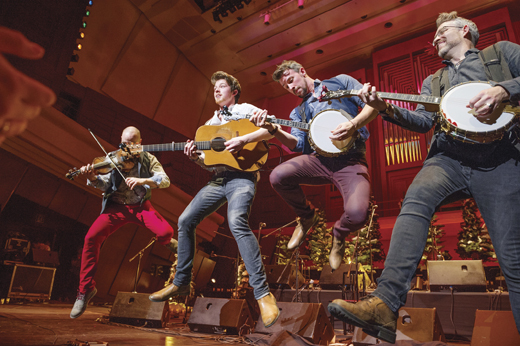
Today, I was in Galway to learn about this seaport city’s unique connection to Americana music – a blend of rock, country, folk, and blues – and what inspired Earle to write the song.
Known as the “City of Tribes” in reference to the 14 families that dominated commerce here for centuries, Galway wears its medieval past in plain sight, cloaked in the remains of Anglo-Norman castles, pre-Cromwell churches, and the remnants of a stone bastion that once provided protection from marauders.
But what has shaped the city’s modern era is less its preservation of history and more its veneration of culture. Film, cuisine, literature, and most often, music are celebrated every year in dozens of festivals. In a country where song and dance remain as indispensable as food and shelter, Galway’s embrace of revelry stands apart.
“Music is really the fabric of what we are in Galway,” Eoghan MacNamara tells me as he stands on Dominick Street outside of the Róisín Dubh music hall.
“The land here in the west has always been naturally wild and untamed, and I suppose that feeds into Galway and its culture, especially its music.”
MacNamara is co-owner of the Róisín Dubh, a Galway staple for nearly 30 years that has drawn Americana acts like the Delines and Josh Ritter. In the late 1990s, it was also frequented by a Texas-born singer and songwriter, Steve Earle.
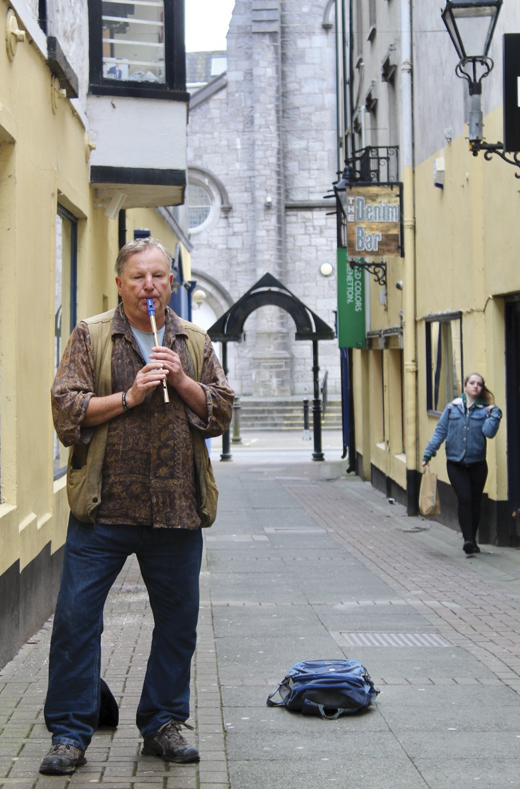
Instrumental similarities between Irish and American music make for a natural transatlantic union – the fusion of fiddles, banjos, and narrative-rich lyrics – but Galway maintains a distinct kinship with Americana.
In the early 1900s, new Irish immigrants – disproportionately from Ireland’s west – brought their instruments and recordings to the American diaspora. Peter “PJ” Conlon, an accomplished accordion player and Galway native, was one of the first to record and sell Irish folk music in the United States. As the Celtic-folk movement accelerated mid-century with the arrival of the Clancy Brothers, Irish music found larger audiences. Soon, Nashville took notice.
Producer Jim Rooney’s six-decade career in Music City included work with Bill Monroe, Nanci Griffith, and John Prine. Arguably the individual most responsible for bringing modern Americana to Ireland, he now splits time between Nashville and Galway, where he’s known to join the occasional seisiún. In Rooney’s autobiography, In It for the Long Run: A Musical Odyssey, he tells of becoming enamored with Irish music after being invited to a fleadh ceol (music festival).
“There were impromptu sessions in every house, pub, out in the street, everywhere.” The singing Rooney witnessed was his introduction to the depth of song tradition in Ireland. “It seemed to come up out of the earth itself.”
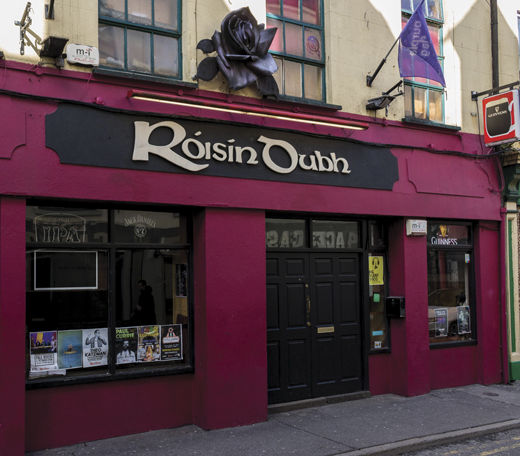
While the bond between Irish music traditions and Americana has shaped over decades, perhaps no band demonstrates this current link more than Galway-based We Banjo 3. The band, heavily influenced by American country and bluegrass artists, refers to their style as “Celtgrass.” Martin Howley, tenor banjo, mandolin, and vocals, is a seven-time all-Ireland banjo champion and the first Irish player to perform at Nashville’s Grand Ole Opry.
“I grew up with my father singing Johnny Cash and Willie Nelson to me and my brother. It was part of who we were, we just didn’t know anything different.”
When Earle arrived in Ireland in 1997, he was five times divorced and had served time in prison for drug and gun offenses, his addictions nearly killing him. Galway might seem a strange place for a recovering addict – the city is often lightheartedly dubbed a “graveyard of ambition” due to its irresistible nightlife – but Earle believed its relative solitude and musical culture outweighed the temptations. Galway would help reignite his creativity.
Adding to Galway’s appeal was Earle’s familiarity with Irish musical traditions. His mentors, Americana founding fathers Guy Clark and Townes Van Zandt, frequently performed throughout Ireland (Van Zandt played his last show at the Róisín Dubh before his death in 1997). Earle had also previously collaborated with the Pogues’ Shane MacGowan and Terry Woods. The two would eventually introduce him to Irish musician Sharon Shannon, with whom Earle would record “The Galway Girl.”
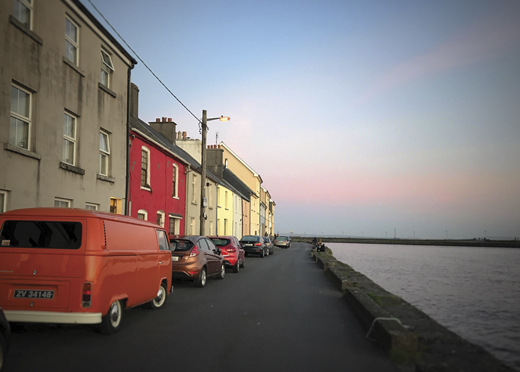
With the wind sideways at my face, I trudged back toward the city, making my way to the Long Walk, the pier where Earle and his companion had strolled. Its one-way street was empty, save for an older man in a faded wool sweater, smoking a cigarette outside a coral row house. As I passed, he acknowledged me with a “hi-ya,” carefully holding his cap to keep from losing it to the bay.
I crossed into Galway’s West End in search of a fire and a pint, and maybe some music. The neighborhood is no more than a few blocks in size but offers a cluster of the city’s most popular live music venues, including Monroe’s and the Crane Bar, pubs that once hosted acts during Galway’s “Americana Festival.” With heavy grey clouds pressing down, I continued quietly mumbling Earle’s lyrics.
We were halfway there when the rain came down
On the day-I-ay-I-ay
Since the song’s release in 2000 there have been efforts to uncover Earle’s muse. Her name remained a mystery to most until 2016 when the book, On Raglan Road: Great Irish Love Songs and the Women Who Inspired Them, identified Joyce Redmond as the object of Earle’s affection. Redmond, also a musician, had met Earle on Quay Street and – as the song suggests – they became close and spent much of their time wandering along Galway’s waterfront.
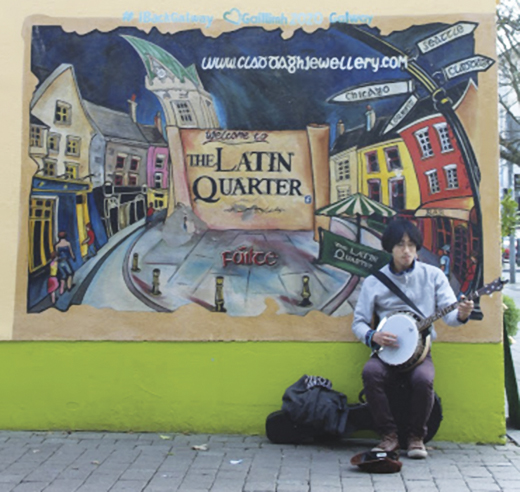
Now 64, Earle still looks the part of the “outlaw country” tag once applied to his musical bent. His wispy beard is mostly gray, and at first glance he could be taken for a gruff, Harley-riding hell raiser –but his demeanor is far from brusque. Soft-spoken and not afraid to smile, these days the three-time Grammy Award-winner could pass for a tenured physics professor.
Reflecting on the popularity of “The Galway Girl” – much of which can be attributed to a version by Irish musician Mundy that reached the top of the Irish charts in 2008 – Earle has said the song may be how he is eventually remembered.
“They’re going to be singing that song in Ireland for a long time. I really do believe that. And that’s the only kind of immortality anybody can hope for.”
My return to Galway ended with a storm – in the most literal sense. Remnants of Hurricane Ophelia came barreling toward Ireland, the largest to hit the island in nearly 50 years. As I worried about miscellaneous dangers the weather imposed, Ophelia’s looming arrival was met in Galway with an apathy and unrelenting jocularity that, in combination, is difficult to find outside of Ireland.
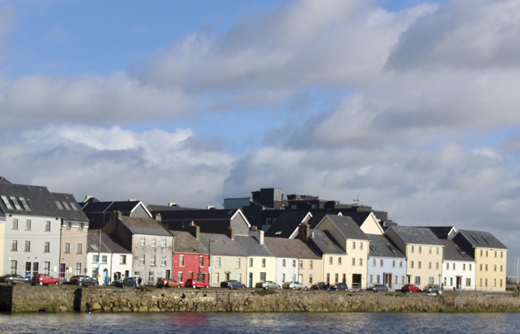
As tides rose and trees bowed the day before my flight home, I sat in Blake’s Bar, named for one of Galway’s infamous tribes. Next to me was a turtle-necked octogenarian, enjoying a pint of cider with her husband.
“What are you doing to prepare for Ophelia?” I asked, anticipating hearing about a stockpile of groceries or plans to head to higher ground.
“Ah, sure love I don’t know. Pray?”
Her response was trailed by a burst of laughter and nurturing pat on my back, a welcome reminder of the joy in not taking things too seriously. The storm passed, as they do, and I left my rented flat in the early morning for a taxi to Shannon Airport.
Standing in the dark, bags in hand, I looked across from the cab stand to a placard in front of Monroe’s that listed upcoming shows: a regular weekly seisiún; an Irish singer-songwriter; Metallica and Pearl Jam tribute bands.
At the bottom of the schedule was Scythian, the American band that introduced me to Earle’s song so many years ago. On the way to the airport, I made a note to catch them back home. ♦

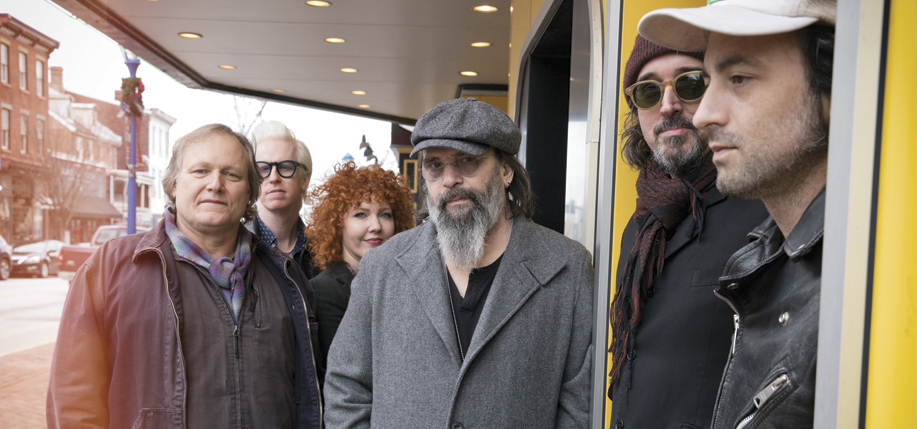
Delightful piece, Gerry. Extremely thoughtful and well researched. Where did you learn all of that? I intend to be in Galway in June, and will take counsel from your informative writings.